
Orange Marmalade
Orange marmalade is, for me, the taste of childhood. I can remember the sound of my grandmother opening a new jar of her homemade marmalade, and the sweet, rich taste of oranges on my English muffin.
Marmalade is one of those fruit spreads that just makes you want to go back for more. It’s not overly sweet, but the complex texture that comes from using the whole orange is just such a joy at breakfast, at brunch, or as a snack.
You know what marmalade really tastes great on? Ice cream. Some of my friends aren’t really big on chocolate, and others like to stay away from nuts. But bring out the marmalade at dessert time, and there’s a rush for the jar! You can really dress up dessert just by adding marmalade to the mix.
There are so many good uses for marmalade. I have a “secret” chicken recipe that uses homemade orange marmalade to enhance the flavor of the chicken. Really, from breakfast through lunch, to dinner and dessert, you could clear your pantry of pretty much every other sauce and just use marmalade. Of course, it tastes so much better if you make it yourself. This recipe doesn’t require any special canning equipment or experience, so do try making it at least once.
What will you put your marmalade on? It could be something as modest as toast. But consider all the possibilities of using that rich, delicious flavor!
Let us know how your marmalade comes out, and what kind of oranges you’re using!
Print
Orange Marmalade
There’s something comforting about the taste and texture of orange marmalade. To make this marmalade, you’ll use the whole fruit, peel, and all. This recipe will keep you in fresh orange marmalade for about six weeks—if it lasts that long! Use it to top our orange scones.
- Prep Time: 30 minutes
- Additional Time: 24 hours
- Cook Time: 3 hours
- Total Time: 1 day 3 hours
- Yield: 62 2-tablespoon servings 1x
- Category: Breakfast
Ingredients
- 2 large navel oranges
- 1 lemon (optional; you can use just oranges if you like)
- 2 cups of water
- 2 cups granulated sugar
Instructions
- Wash your citrus thoroughly.
- Chop citrus into small pieces—peel and all! Be sure to remove seeds as you find them.
- Put the chopped fruit into a heavy steel pot that has a tight-fitting lid (you’ll need it later).
- Cover the chopped fruit with the 2 cups of water and bring the mixture to a simmer over medium heat.
- Add the sugar and bring the mixture to a boil, stirring frequently. Take care that the mixture doesn’t burn.
- Once the sugar is dissolved, cover the pot tightly, remove the pot from the heat, and let it sit overnight at room temperature.
- The next day, bring the mixture up to a boil.
- Reduce the heat to low.
- Simmer, uncovered, for about 2 hours. Stir occasionally.
- After 2 hours of simmering, turn up the heat and boil the mixture gently for another 30 minutes. If foam forms on the top, skim it off and discard it.
- Check the temperature of the mixture: it needs to reach 220 degrees F for the natural pectin in the oranges to gel up with the sugar.
- Test the marmalade for readiness by putting a dollop on a chilled plate and leaving it in the fridge for about 10 minutes. If the dollop pretty much holds its shape, you’re all set. If it’s still runny, cook the mixture a little more. If the dollop is too hard, add a bit of water to the pot.
- Once your mixture is the right consistency, spoon it into sterilized jars and seal with lids. Chill in the fridge.
- Your marmalade may need 24 to 48 hours to set up; be patient!
- Keep marmalade in the fridge in sealed jars for up to 6 weeks.
Have you tried making this marmalade? Did you include lemon or use all oranges? Please tell us how it turned out for you.


 Previous
Previous

